You are using an out of date browser. It may not display this or other websites correctly.
You should upgrade or use an alternative browser.
You should upgrade or use an alternative browser.
Export thread
This is what happens when you overcharge a lead acid battery
#1

MowerMike
MowerMike
So, I left the battery pack for my Earthwise 14" battery powered mower connected unattended in my spare bedroom to my "smart" charger, which is supposed to switch automatically to a trickle charge maintenance mode on the battery has fully recharged, when I noticed a very strong smell coming from the bedroom. When I walked in I was shocked to see that the battery was scalding hot, the plastic case was warped and there was battery acid leaking out at the top. I quickly turned off the charger, which was also extremely hot, and took the battery outside, where I removed the cover and took some pictures.
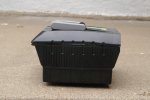
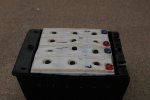
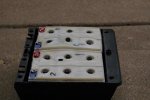
Note the the bottom of the case has bulged out and the case no longer sits flat on the ground. Also the top of the case and battery tops are bulged upwards as well. A replacement battery costs more than I paid for the entire mower, so I've just ordered a pair of wheelchair/scooter batteries that will cost less than half as much and just wire them directly into the mower. I will have to charge them in the mower and make up different wires for the F2 terminals, but that is the only downside.



Note the the bottom of the case has bulged out and the case no longer sits flat on the ground. Also the top of the case and battery tops are bulged upwards as well. A replacement battery costs more than I paid for the entire mower, so I've just ordered a pair of wheelchair/scooter batteries that will cost less than half as much and just wire them directly into the mower. I will have to charge them in the mower and make up different wires for the F2 terminals, but that is the only downside.
#2

MowerMike
MowerMike
My home made replacement battery saved me $63
Well, the replacement batteries arrived yesterday and I successfully wired them into my mower per the attached photos. I used 12 AWG wire and crimp connectors throughout and made up spacers with some old closed cell foam I had lying around. I was able to salvage the spring connector piece from the battery pack that connects it to the mower, so I will be able to unplug the batteries w/o cutting any wires or pulling apart the terminals. The battery can be charged inside the mower by plugging the charger into a port at the rear of the mower. Since the battery terminals are exposed, I can check the charging status directly with a voltmeter w/o having to start the mower. The only concern I have is that the manufacturing date codes on the batteries is April, 2011, which makes them over 2 years old and may mean a reduced service life. They did charge up properly and the mower works well so I'm crossing my fingers. I'm using the OEM charger instead of the aftermarket "smart" charger that destroyed the original battery.
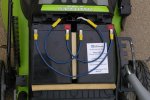
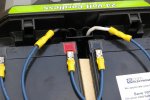
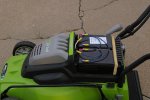

Well, the replacement batteries arrived yesterday and I successfully wired them into my mower per the attached photos. I used 12 AWG wire and crimp connectors throughout and made up spacers with some old closed cell foam I had lying around. I was able to salvage the spring connector piece from the battery pack that connects it to the mower, so I will be able to unplug the batteries w/o cutting any wires or pulling apart the terminals. The battery can be charged inside the mower by plugging the charger into a port at the rear of the mower. Since the battery terminals are exposed, I can check the charging status directly with a voltmeter w/o having to start the mower. The only concern I have is that the manufacturing date codes on the batteries is April, 2011, which makes them over 2 years old and may mean a reduced service life. They did charge up properly and the mower works well so I'm crossing my fingers. I'm using the OEM charger instead of the aftermarket "smart" charger that destroyed the original battery.




#4

MowerMike
MowerMike
I revised the battery wiring
Well, it's been over a year since I replaced the batteries, and it's still running great. One thing I was never happy with was the way I originally wired the batteries. For one thing, the two adjacent live battery terminals were only an inch apart with a 24 volt drop across them. I have a 24 volt charger with alligator clamps that I didn't dare use due fear of shorting them. Also, I had to use a lot of wire to connect the two batteries in series. So, I've rewired the batteries as shown with a short jumper piece in the middle and the + and - connections to the mower on the outside, which has reduced the total length of wire by over a foot. As you can see from the before and after photos, the wiring is a lot tidier and I can easily connect alligator clamps for attachment to my 24 volt fast charger.
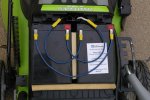
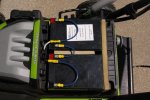
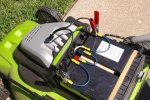
Well, it's been over a year since I replaced the batteries, and it's still running great. One thing I was never happy with was the way I originally wired the batteries. For one thing, the two adjacent live battery terminals were only an inch apart with a 24 volt drop across them. I have a 24 volt charger with alligator clamps that I didn't dare use due fear of shorting them. Also, I had to use a lot of wire to connect the two batteries in series. So, I've rewired the batteries as shown with a short jumper piece in the middle and the + and - connections to the mower on the outside, which has reduced the total length of wire by over a foot. As you can see from the before and after photos, the wiring is a lot tidier and I can easily connect alligator clamps for attachment to my 24 volt fast charger.



#5

MowerMike
MowerMike
So, one of the batteries is now dead and leaking acid. It was advertised as "non-spillable", so I guess that's what I get for buying cheap Chinese batteries on the internet. I haven't used this mower for quite awhile since getting several newer lithium-ion battery mowers, so I won't bother replacing the battery. It was quite heavy and had very small wheels, so it was very hard to push.
#7
B
bertsmobile1
B
bertsmobile1
Despite the fact this is a very old thread.
1) never trust "smart" chargers because they are not smart and they are not good for the battery either.
2) battery tenders are just the same as smart chargers, use the same control chip, cost 2 to 4 times as much and have a lower max charge rate & duty cycle.
3) almost none of them will recharge a dead flat battery and when they do they damage them thus shortening their life then the makers blame you for putting them on a dead flat battery.
Best way is to hook a standard charger to the battery through a timer switch.
for a charged battery, 15 minutes once a week is all they need to keep them in tip top condition.
1) never trust "smart" chargers because they are not smart and they are not good for the battery either.
2) battery tenders are just the same as smart chargers, use the same control chip, cost 2 to 4 times as much and have a lower max charge rate & duty cycle.
3) almost none of them will recharge a dead flat battery and when they do they damage them thus shortening their life then the makers blame you for putting them on a dead flat battery.
Best way is to hook a standard charger to the battery through a timer switch.
for a charged battery, 15 minutes once a week is all they need to keep them in tip top condition.
#8

MowerMike
The charger that destroyed the original battery was a Schumacher (DSR) INC-2405A, 24Vdc, 5A. Curiously, it works fine with a different battery that uses AGM technology, so I'm not quite sure if the problem may have been at least in part caused by the battery itself. In any event, I no longer leave any chargers connected for more than 12 hours at a time.
MowerMike
What 'smart-charger' did the overcharging ?
I only use the brand Battery MINDers* myself.
The charger that destroyed the original battery was a Schumacher (DSR) INC-2405A, 24Vdc, 5A. Curiously, it works fine with a different battery that uses AGM technology, so I'm not quite sure if the problem may have been at least in part caused by the battery itself. In any event, I no longer leave any chargers connected for more than 12 hours at a time.
#9

7394
7394
I think it may have been the battery also.. 5Amp is a lot for a "smart charger" as you posted tho.
I leave my bikes & mowers hooked up to Battery MINDers* all winter long, never an issue. Mine are only 1.5 & a .75Ma
I leave my bikes & mowers hooked up to Battery MINDers* all winter long, never an issue. Mine are only 1.5 & a .75Ma
#10

Teds
Teds
Charging lead-acid type batteries indoors or around living quarters is not advisable, not simply just because of the explosion hazard. Batteries produce hydrogen during charging as is well known but there are also other lesser known chemicals produced during outgassing that are toxic. When the battery manufacturers say use "good ventilation" they mean it.
#11

7394
7394
I agree with that Ted.
My truck battery is just over 10 years old & still tests as practically new, & load tested as well.
My truck battery is just over 10 years old & still tests as practically new, & load tested as well.
#12

MowerMike
It depends on the type of SLA battery. Car batteries are wet type sealed, so they can overheat and leak both liquid and gas. Dry AGM batteries that are used in UPS and alarm systems are not supposed to leak even if overcharged.
MowerMike
Charging lead-acid type batteries indoors or around living quarters is not advisable, not simply just because of the explosion hazard. Batteries produce hydrogen during charging as is well known but there are also other lesser known chemicals produced during outgassing that are toxic. When the battery manufacturers say use "good ventilation" they mean it.
It depends on the type of SLA battery. Car batteries are wet type sealed, so they can overheat and leak both liquid and gas. Dry AGM batteries that are used in UPS and alarm systems are not supposed to leak even if overcharged.
#13
K
Kial
K
Kial
Wow! Good thing you saw it when you did. More proof that regardless of what the manufacturer says it's never a good idea to just leave the battery in the charger.
#14
M
motoman
M
motoman
I run 6 batteries , and have tried various types of chargers across the years. The small H Frt stuff "was" worthless, probably because of cheap components and packaging. I was with Shumacher also for years . Their support sucked. The smart charger I had for about 4 years worked well until it also became unresponsive. A smaller trickle charger crapped out too soon, and the latest trickle charger hook broke almost immediately , but is working as a float unit.
Always adventuresome, today bought the "latest" H Frt smart unit with coupon. It has a touch screen, winter mode and repair mode. I just used it on 3 batteries which were finished in good order and will try the "repair" mode on a sulfated or shorted unit (aged) in the shop. The new unit could be junk, but the theory of the smart chargers is good. I have some faith in the H Frt (and Amazon) testimonials as they have published some of my gripes as I sent them.
Although I have never had a scary event with the "flooded" (lead acid) batteries every instruction pamphlet is loaded with warnings of explosion and acid burn hazard. Online there are many good articles on batteries, specific gravity, surface charge, charging curves, and load testing for the interested. I could not find any manufacturer of household type chargers made in USA. I have never had a bad experience leaving any charger advertised as a float or maintainer hooked up indefinitely.
Always adventuresome, today bought the "latest" H Frt smart unit with coupon. It has a touch screen, winter mode and repair mode. I just used it on 3 batteries which were finished in good order and will try the "repair" mode on a sulfated or shorted unit (aged) in the shop. The new unit could be junk, but the theory of the smart chargers is good. I have some faith in the H Frt (and Amazon) testimonials as they have published some of my gripes as I sent them.
Although I have never had a scary event with the "flooded" (lead acid) batteries every instruction pamphlet is loaded with warnings of explosion and acid burn hazard. Online there are many good articles on batteries, specific gravity, surface charge, charging curves, and load testing for the interested. I could not find any manufacturer of household type chargers made in USA. I have never had a bad experience leaving any charger advertised as a float or maintainer hooked up indefinitely.
#15

7394
7394
I like the Battery MINDer* 1500, comes with an external temp compensator, & 5 Year warranty. There is also a 1510 that has a 10 year warranty.
#16
M
motoman
M
motoman
Those are great warranties which are paid for in the higher unit prices, I suppose. In contrast the new H Frt unit I bought was cheap . They offered 1 and 2 yr warranties for $20+ which I passed up. I will work the unit heavily for the 90 day warranty and hope for the best. Your brand probably has better grade parts, also.
#17
B
bertsmobile1
B
bertsmobile1
Now batteries have changed a little bit since I was making them in the 80's but the chemistry behind them has not.
The easiest thing to do is get a dumb charger and a timer.
To keep the battery in tip top condition, set the timer for 10 to 15 minutes a week and leave the charger on full power settings.
Auto chargers really do not work because you can not properly determine the condition of the battery electronically without doing a max discharge and full load test.
Also different batteries require different charging voltages so hooking a sealed paste filled battery onto a flooded cell charger is a recepie for a hot date with a fireman
Pb-Ca
Pb-Pb
Sn-Pb
Pb/Ag-Pb
flooded cell batteries all require different floating voltages but few chargers under $ 100 can determine which cell they are hooked up to.
Then you have Gel Cells , AGM & PVR AGM and again each one has a specific charging regime if you are to get the best use out of them.
All the rot about pulsed cleaning and over voltage desulfating of the plates only works on the batteries that used to be made 50 years ago when plates had 3 mm thick grids coated on both side with another 3 mm of high bond strength paste.
Search "the battery university" to get all of the grubby facts.
The easiest thing to do is get a dumb charger and a timer.
To keep the battery in tip top condition, set the timer for 10 to 15 minutes a week and leave the charger on full power settings.
Auto chargers really do not work because you can not properly determine the condition of the battery electronically without doing a max discharge and full load test.
Also different batteries require different charging voltages so hooking a sealed paste filled battery onto a flooded cell charger is a recepie for a hot date with a fireman
Pb-Ca
Pb-Pb
Sn-Pb
Pb/Ag-Pb
flooded cell batteries all require different floating voltages but few chargers under $ 100 can determine which cell they are hooked up to.
Then you have Gel Cells , AGM & PVR AGM and again each one has a specific charging regime if you are to get the best use out of them.
All the rot about pulsed cleaning and over voltage desulfating of the plates only works on the batteries that used to be made 50 years ago when plates had 3 mm thick grids coated on both side with another 3 mm of high bond strength paste.
Search "the battery university" to get all of the grubby facts.
#18
M
motoman
M
motoman
I will report on this purchase after the 90 day warranty. I like the mechanical design with a good handle , triangular package with heavy base to resist tippping over like the last one did. Very easy touch screen symbols and response . The unit shuts down after it completes the chosen input. I have not observed yet if it starts up again for the "float" charging. I wonder what the UL acceptance testing looks at on these things, surely "fire hazard" ? But maybe only wire gauge and insulation?
#19
B
bertsmobile1
B
bertsmobile1
IF it came from some place like HF it would be type tested, hanging on the coat tails of a model 15 years ago, testing costs money.
While modern solid state electronics has come leaps & bounds I avoid things like touch screens like the plague.
I still have , and use a charger from 1954 with a multi wired transformer so I can set it anywhere from 2 V to 100V and a nice big resistor so the current can be varied from 20 A right down to 0.1 A .
Because it uses mechanical switches, it will run forever. If left in the sun I can still read the panel & change it of left in the rain it still works and being properly earthed ( grounded ) again chugs along happily.
It can be left hooked up to a vehicle overnight with a heavy dew without worry. Hook it up backwards and it either blows the fuse , right there on the top panel or trips a breaker around the back.
It has 30 feet of power cord and 15 feet of hook up leads.
Downside is you have to remember you turned it on then go back and turn it down or off.
Apparently using ones brain is way do difficult now days.
There is a back up from 1972, a cheapie with 4 out put sockets 2V 6V 12V & 24V which requires the operator to carry out the onerous task of pulling out the plug and putting it into the correct socket then selecting a position on the 3 position switch Hi Med Low.
The analog voltmeter and amp meter on the front panel can be read for 20 ' away and again, never goes black if the sun should ever shine directly on it for more than 15 seconds.
Can not remember just how many times I have loaned this charger out to friends & fellow club members because their you beaut modern dose everything but make your morning coffee battery charger died.
I went to a petrol Station closing down sale last year.
One of the big supermarkets bought the site and was going to convert the 6 car workshop into a convienence store to challenge the 7-11 on the other side of the corner.
When they came to the battery chargers , they were listed as , very old- mechanical - rusty case - meters not working estimate $ 50.
Similar units to my 1954 one.
One went for $ 790 and the other which some one threw a few sparks with went for $ 1800
While modern solid state electronics has come leaps & bounds I avoid things like touch screens like the plague.
I still have , and use a charger from 1954 with a multi wired transformer so I can set it anywhere from 2 V to 100V and a nice big resistor so the current can be varied from 20 A right down to 0.1 A .
Because it uses mechanical switches, it will run forever. If left in the sun I can still read the panel & change it of left in the rain it still works and being properly earthed ( grounded ) again chugs along happily.
It can be left hooked up to a vehicle overnight with a heavy dew without worry. Hook it up backwards and it either blows the fuse , right there on the top panel or trips a breaker around the back.
It has 30 feet of power cord and 15 feet of hook up leads.
Downside is you have to remember you turned it on then go back and turn it down or off.
Apparently using ones brain is way do difficult now days.
There is a back up from 1972, a cheapie with 4 out put sockets 2V 6V 12V & 24V which requires the operator to carry out the onerous task of pulling out the plug and putting it into the correct socket then selecting a position on the 3 position switch Hi Med Low.
The analog voltmeter and amp meter on the front panel can be read for 20 ' away and again, never goes black if the sun should ever shine directly on it for more than 15 seconds.
Can not remember just how many times I have loaned this charger out to friends & fellow club members because their you beaut modern dose everything but make your morning coffee battery charger died.
I went to a petrol Station closing down sale last year.
One of the big supermarkets bought the site and was going to convert the 6 car workshop into a convienence store to challenge the 7-11 on the other side of the corner.
When they came to the battery chargers , they were listed as , very old- mechanical - rusty case - meters not working estimate $ 50.
Similar units to my 1954 one.
One went for $ 790 and the other which some one threw a few sparks with went for $ 1800
#20
M
motoman
M
motoman
Well, my "modern" units have had a relatively short life which I attribute to cheap Chinese components. But they are doing better with their quality. Theory of solid state components like resistors and transistor chips is that good ones last "forever." Consider the switching of a transistor compared with a set of breaker points. Weight , by itself, is not a standard anymore. The smart units I have had (now 2) DO seem to work, just not last. I think they are fragile and subject to handling damage where parts can break on the circuit boards . One cannot criticize the ignition modules on our small, air cooled engines as the good ones are a marvel of "chip" engineering. I have noticed a fall off in advertising of "desulfate" or repair on these smart chargers. Perhaps because the public expects miracles. Read the testimonials and consider. I will report as noted , at first failure.
#21
B
bertsmobile1
B
bertsmobile1
And just like the embedded hall effect trigger chip in coils, which regularly fails and then makes the entire assembly trash because a 50¢ chip ( yes that is what they cost to make and that is 50¢ AUS ) fails you have to replace the entire coil for $ 50.00.
While they are good, the voltage from some early volt meters was enough to fry them and even now , a momentary connection to 12V burns them out, A miracle all right, a miracle of modern marketing.
There is no reason to embed them when they have no protection circuit.
And that is the big problem with solid state gear, the total lack of ELECTRICAL protection against spikes, back flows , over voltage , excessive current or reverse polarity.
In an attempt to make greater profits or just cheaper purchase prices very few circuit boards have any enviromental protection so if you leave the charger connected to a car, sitting under the hood overnight on a heavy due night, condensation will short out the boards.
The owners then blame themselves and go out & buy another one.
While they are good, the voltage from some early volt meters was enough to fry them and even now , a momentary connection to 12V burns them out, A miracle all right, a miracle of modern marketing.
There is no reason to embed them when they have no protection circuit.
And that is the big problem with solid state gear, the total lack of ELECTRICAL protection against spikes, back flows , over voltage , excessive current or reverse polarity.
In an attempt to make greater profits or just cheaper purchase prices very few circuit boards have any enviromental protection so if you leave the charger connected to a car, sitting under the hood overnight on a heavy due night, condensation will short out the boards.
The owners then blame themselves and go out & buy another one.
